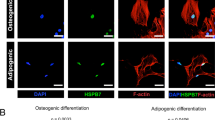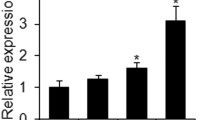Abstract
Bone marrow-derived mesenchymal stem cells (BM-MSCs) have the capacity to differentiate into osteoblasts and adipocytes. Bone marrow adipogenesis exerts an inhibitory effect on osteogenesis, which leads to osteoporosis. S100A16, a novel member of the S100 family, is ubiquitously expressed, and markedly enhances adipogenesis. The aim of this study was to demonstrate, in the mouse BM-MSC model, whether S100A16 significantly stimulates adipogenic, rather than osteogenic differentiation. The overexpression of S100A16 led to a significant increase in Oil Red O staining (a marker of adipocyte differentiation) but a decrease in Alizarin Red S staining (a marker of osteoblast differentiation). In contrast, reducing the expression of S100A16 resulted in minimal Oil Red O staining but increased Alizarin Red S staining. During differentiation into osteoblasts, RUNX2 expression increased fourfold in the S100A16KO+/− BM-MSCs, but only increased by approximately 1.5-fold in the S100A16TG+/+ BM-MSCs. And BMP2 occurred in the same changes. Upon induction of BM-MSC differentiation into adipocytes, peroxisome proliferator-activated receptor-γ (PPARγ) and CCAAT/enhancer binding protein-α expression were significantly higher in the cells overexpressing S100A16 protein but lower in the cells with reduced expression of S100A16 protein, compared with the control cells, which were BM-MSCs derived from C57/BL6. S100A16 increased PPARγ promoter luciferase activity and decreased RUNX2 promoter luciferase activity. ERK1/2 phosphorylation was stimulated during osteogenesis, whereas p-JNK phosphorylation was increased by stimulation of adipogenesis. Our results suggest that S100A16 inhibits osteogenesis but stimulates adipogenesis by increasing the transcription of PPARγ and decreasing the transcription of RUNX2. The ERK1/2 pathway is involved in the regulation of osteogenesis whereas the JNK pathway is involved in adipogenesis.




Similar content being viewed by others
References
Cohen-Solal M, de Vernejoul MC (2003) Bone remodeling. Therapie 58(5):391–393
LB Eriksen EF, Langdahl BL (1997) The pathogenesis of osteoporosis. Horm Res 48(Suppl 5):78–82
Tokcaer-Keskin Z, Akar AR, Ayaloglu-Butun F, Terzioglu-Kara E, Durdu S, Ozyurda U, Ugur M, Akcali KC (2009) Timing of induction of cardiomyocyte differentiation for in vitro cultured mesenchymal stem cells: a perspective for emergencies. Can J Physiol Pharmacol 87(2):143–150
Cheng H, Qiu L, Ma J, Zhang H, Cheng M, Li W, Zhao X, Liu K (2011) Replicative senescence of human bone marrow and umbilical cord derived mesenchymal stem cells and their differentiation to adipocytes and osteoblasts. Mol Biol Rep 38(8):5161–5168
Zhang Y, Zhou P, Kimondo JW (2012) Adiponectin and osteocalcin: relation to insulin sensitivity. Biochem Cell Biol 90(5):613–620
Baksh D, Song L, Tuan RS (2004) Adult mesenchymal stem cells: characterization, differentiation, and application in cell and gene therapy. J Cell Mol Med 8(3):301–316
Zhang M, Mal N, Kiedrowski M, Chacko M, Askari AT, Popovic ZB, Koc ON, Penn MS (2007) SDF-1 expression by mesenchymal stem cells results in trophic support of cardiac myocytes after myocardial infarction. FASEB J 21(12):3197–3207
Kondo T, Johnson SA, Yoder MC, Romand R, Hashino E (2005) Sonic hedgehog and retinoic acid synergistically promote sensory fate specification from bone marrow-derived pluripotent stem cells. Proc Natl Acad Sci U S A 102(13):4789–4794
Gregoire FM, Smas CM, Sul HS (1998) Understanding adipocyte differentiation. Physiol Rev 78(3):783–809
Chen C, UIudag H, Wang Z, Jiang H (2012) Noggin suppression decreases BMP-2-induced osteogenesis of human bone marrow-derived mesenchymal stem cells in vitro. J Cell Biochem. doi:10.1002/jcb.24240
Smith KE, Huang Z, Ma T, Irani A, Lane Smith R, Goodman SB (2011) Molecular profile of osteoprogenitor cells seeded on allograft bone. J Tissue Eng Regen Med 5(9):704–711
Nathan SS, Pereira BP, Zhou YF, Gupta A, Dombrowski C, Soong R, Pho RW, Stein GS, Salto-Tellez M, Cool SM, van Wijnen AJ (2009) Elevated expression of Runx2 as a key parameter in the etiology of osteosarcoma. Mol Biol Rep 36(1):153–158
Marenholz I, Heizmann CW, Fritz G (2004) S100 proteins in mouse and man: from evolution to function and pathology (including an update of the nomenclature). Biochem Biophys Res Commun 322(4):1111–1122
Liu Y, Zhang R, Xin J, Sun Y, Li J, Wei D, Zhao AZ (2011) Identification of S100A16 as a novel adipogenesis promoting factor in 3T3-L1 cells. Endocrinology 152(3):903–911
Sung JH, Yang HM, Park JB, Choi GS, Joh JW, Kwon CH, Chun JM, Lee SK, Kim SJ (2008) Isolation and characterization of mouse mesenchymal stem cells. Transplant Proc 40(8):2649–2654
Oei L, Rivadeneira F, Ly F, Breda SJ, Zillikens MC, Hofman A, Uitterlinden AG, Krestin GP, Oei EH (2012) Review of radiological scoring methods of osteoporotic vertebral fractures for clinical and research settings. Eur Radiol. Epub ahead of print
Zhang JF, Li G, Meng CL, Dong Q, Chan CY, He ML, Leung PC, Zhang YO, Kung HF (2009) Total flavonoids of Herba Epimedii improves osteogenesis and inhibits osteoclastogenesis of human mesenchymal stem cells. Phytomedicine 16(6–7):521–529
Delorme B, Chateauvieux S, Charbord P (2006) The concept of mesenchymal stem cells. Regen Med 1(4):497–509
Rosen CJ, Bouxsein ML (2006) Mechanisms of disease: is osteoporosis the obesity of bone? Nat Clin Pract Rheumatol 2(1):35–43
Zhou S, Greenberger JS, Epperly MW, Goff JP, Adler C, Leboff MS, Glowacki J (2008) Age-related intrinsic changes in human bone-marrow-derived mesenchymal stem cells and their differentiation to osteoblasts. Aging Cell 7(3):335–343
Chamberlain G, Fox J, Ashton B, Middleton J (2007) Concise review: mesenchymal stem cells: their phenotype, differentiation capacity, immunological features, and potential for homing. Stem Cells 25(11):2739–2749
Rosen CJ, Ackert-Bicknell C, Rodriguez JP, Pino AM (2009) Marrow fat and the bone microenvironment: developmental, functional, and pathological implications. Crit Rev Eukaryot Gene Expr 19(2):109–124
Wang Y, Wan C, Gilbert SR, Clemens TL (2007) Oxygen sensing and osteogenesis. Ann N Y Acad Sci 1117:1–11
Duque G, Troen BR (2008) Understanding the mechanisms of senile osteoporosis: new facts for a major geriatric syndrome. J Am Geriatr Soc 56(5):935–941
Maurin AC, Chavassieux PM, Frappart L, Delmas PD, Serre CM, Meunier PJ (2000) Influence of mature adipocytes on osteoblast proliferation in human primary cocultures. Bone 26(5):485–489
Musacchio E, Priante G, Budakovic A, Baggio B (2007) Effects of unsaturated free fatty acids on adhesion and on gene expression of extracellular matrix macromolecules in human osteoblast-like cell cultures. Connect Tissue Res 48(1):34–38
Lecka-Czernik B (2006) PPARs and bone metabolism. PPAR Res 2006:18089
Gimble JM, Zvonic S, Floyd ZE, Kassem M, Nuttall ME (2006) Playing with bone and fat. J Cell Biochem 98(2):251–266
Akune T, Ogata N, Hoshi K, Kubota N, Terauchi Y, Tobe K, Takagi H, Azuma Y, Kadowaki T, Nakamura K, Kawaguchi H (2002) Insulin receptor substrate-2 maintains predominance of anabolic function over catabolic function of osteoblasts. J Cell Biol 159(1):147–156
Wan Y, Chong LW, Evans RM (2007) PPAR-gamma regulates osteoclastogenesis in mice. Nat Med 13(12):1496–1503
Lazarenko OP, Rzonca SO, Hogue WR, Swain FL, Suva LJ, Lecka-Czernik B (2007) Rosiglitazone induces decreases in bone mass and strength that are reminiscent of aged bone. Endocrinology 148(6):2669–2680
Acknowledgments
This work was supported by grants from the National Natural Science Foundation of China (No. 81270952, 81070684) and the Jiangsu Province’s Key Provincial Talents Program (BE 2011802), the Project Funded by the Priority Academic Program Development of Jiangsu Higher Education Institutions, the special scientific research project from the Ministry of health, China (No. 201002002), the Projects in the Jiangsu Science & Technology Pillar Program (BE 2011802).
Conflict of interest
The authors declare that they have no conflict of interest.
Author information
Authors and Affiliations
Corresponding author
Rights and permissions
About this article
Cite this article
Li, D., Zhang, R., Zhu, W. et al. S100A16 inhibits osteogenesis but stimulates adipogenesis. Mol Biol Rep 40, 3465–3473 (2013). https://doi.org/10.1007/s11033-012-2413-2
Received:
Accepted:
Published:
Issue Date:
DOI: https://doi.org/10.1007/s11033-012-2413-2




